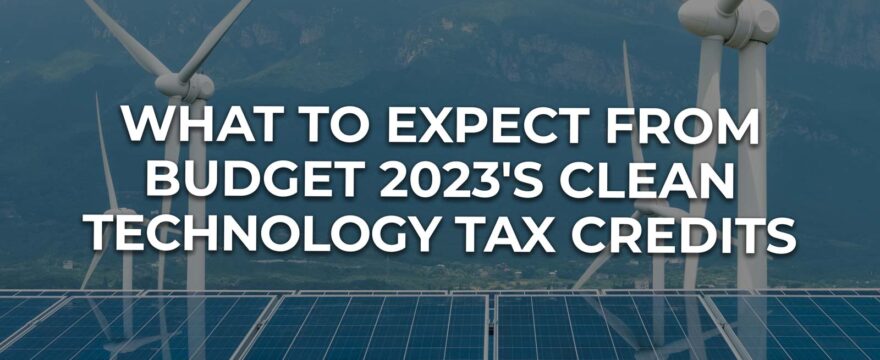
With the 2023 Federal Budget just around the corner, many of Canada’s innovators have their attention keenly focused on an announcement regarding the upcoming Clean Technology tax credits proposed by the Liberal Government in 2022. As an ambitious part of the Government’s 2030 Emissions Reduction Plan (ERP), designed to reach its net zero commitments by 2050, the tax credits are a valuable resource for businesses and innovators to pursue once final details are announced. Below, we’ll take a closer look at some of the guidelines as disclosed by the Government of Canada, as well as the benefits of pairing these new tax incentives with additional resources like the Scientific Research & Experimental Development (SR&ED program). Read on to learn more!
What to Expect from the 2023 Clean Tech, Clean Hydrogen and Carbon Capture & Utilization Tax Credits?
While we’re still waiting on the final word with regard to the details of the credits and incentives for businesses and developers, the following is what has been disclosed thus far:
1. The total projected investment in the government’s refundable Clean Tech tax credit is an estimated $6.7 billion to be expended over five years. This equates to 30% of the cost of investments in clean technology-based assets like:
- Clean electricity generation (wind, solar, small hydropower and small nuclear reactors)
- Stationary electric storage
- The use of low-carbon heat equipment, including heat pumps and solar heating.
- Industrial zero-emission vehicles, as well as related charging and/or refuelling equipment.
2. Companies that abide by the specified labour conditions will be eligible for the full 30% credit, while those who do not will only receive 20%. The designated labour conditions have yet to be released (pending consultation with a group of external stakeholders) but are expected to include paying labour market fair wages and the provision of apprenticeship training for employees to ensure a continued priority and evolution of clean technology within the market.
3. On August 23, 2022, the Canadian and German governments voiced a joint declaration of intent to invest in hydrogen projects to supplement the increasing global demand for renewable energy. At this time, the government also announced the establishment of the Clean Hydrogen Credit, designed to support further investments in the production of clean hydrogen within Canada. The Clean Hydrogen Credit will be refundable and available as of budget day 2023, with the lowest carbon intensity tier meeting all eligible requirements (TBD) and receiving a tax credit of at least 40%. Similar to the clean tech credit, in circumstances where labour conditions are not met, the maximum credit will be reduced to 30%. As with the Clean Tech Credit, The Clean Hydrogen Credit is short-term, with a planned phaseout for the end of 2030.
4. The 2022 federal budget outlined details for the Carbon Capture & Utilization (CCUS) credit, which will apply for CCUS projects that permanently sequester CO2, with the exclusion of oil recovery projects. The tax credit rates from 2022-2030 are set at 60% for the investment in equipment to capture CO2 in direct air capture projects, 50% for CO2 Capturing in all other CCUS projects and 37.5% for the investment of equipment for transportation, storage, and usage of stored CO2.
Combining Government Clean Technology Credits with SR&ED
The Clean Tech, Clean Hydrogen and CCUS refunds are poised to offer Canadian business owners a valuable opportunity to capitalize on their commitment to innovation and development. When paired with other tax incentives like the SR&ED program, these credits can be a significant source of funding for research and development (R&D) and help you to maintain full control of your operations through the pursuit of non-dilutive capital.
Bridging Funding Gaps with Capital-As-A-Service Solutions
One of the biggest challenges facing business recipients of government support such as tax incentive refunds is the time it takes to receive your funding. For those pursuing Scientific Research and Experimental Development (SR&ED) tax credit refunds, the delay between acceptance and funding can be detrimental to your ability to keep initiatives rolling. In the interim, operators face the choice of seeking equity-based capital that may require them to sacrifice valuable control over their company at inopportune times or seek alternative sources of funding.
At Easly, we know just how important it is to have access to funds when it matters most. With decades of experience behind our team, Easly is proud to be a trusted source of financing for successful SR&ED program claimants. When you partner with us and finance your SR&ED refund, you’ll enjoy the benefits of fast access to funding from a provider with over $118 million in capital deployed. You can receive your capital in as little as two weeks.
For those looking to maximize government initiative funding in 2023, SR&ED and the Clean Tech and Clean Hydrogen Credits are valuable avenues to explore. To learn more about the role of SR&ED refund financing in your company’s capital-raising efforts, contact Easly today!
.png)
.png)
.png)
